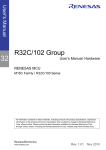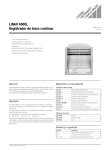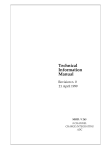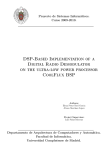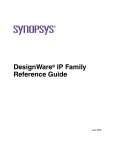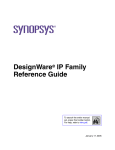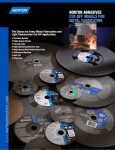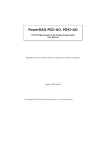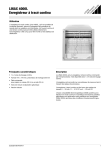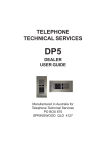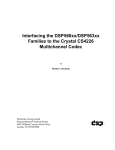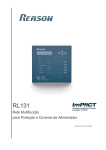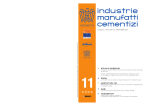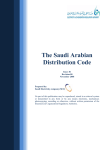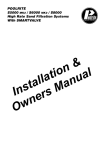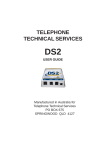Download R32C/102 Group User`s Manual: DSP
Transcript
User's Manual 32 R32C/102 Group User's Manual: DSP R32C/102 Group User’s Manual: DSP RENESAS MCU M16C Family / R32C/100 Series All information contained in these materials, including products and product specifications, represents information on the product at the time of publication and is subject to change by Renesas Electronics Corp. without notice. Please review the latest informaton published by Renesas Electronics Corp. through various means, including the Renesas Electronics Corp. website (http://www.renesas.com). www.renesas.com Rev. 1.00 May 2011 Notice 1. 2. 3. 4. 5. 6. 7. All information included in this document is current as of the date this document is issued. Such information, however, is subject to change without any prior notice. Before purchasing or using any Renesas Electronics products listed herein, please confirm the latest product information with a Renesas Electronics sales office. Also, please pay regular and careful attention to additional and different information to be disclosed by Renesas Electronics such as that disclosed through our website. Renesas Electronics does not assume any liability for infringement of patents, copyrights, or other intellectual property rights of third parties by or arising from the use of Renesas Electronics products or technical information described in this document. No license, express, implied or otherwise, is granted hereby under any patents, copyrights or other intellectual property rights of Renesas Electronics or others. You should not alter, modify, copy, or otherwise misappropriate any Renesas Electronics product, whether in whole or in part. Descriptions of circuits, software and other related information in this document are provided only to illustrate the operation of semiconductor products and application examples. You are fully responsible for the incorporation of these circuits, software, and information in the design of your equipment. Renesas Electronics assumes no responsibility for any losses incurred by you or third parties arising from the use of these circuits, software, or information. When exporting the products or technology described in this document, you should comply with the applicable export control laws and regulations and follow the procedures required by such laws and regulations. You should not use Renesas Electronics products or the technology described in this document for any purpose relating to military applications or use by the military, including but not limited to the development of weapons of mass destruction. Renesas Electronics products and technology may not be used for or incorporated into any products or systems whose manufacture, use, or sale is prohibited under any applicable domestic or foreign laws or regulations. Renesas Electronics has used reasonable care in preparing the information included in this document, but Renesas Electronics does not warrant that such information is error free. Renesas Electronics assumes no liability whatsoever for any damages incurred by you resulting from errors in or omissions from the information included herein. Renesas Electronics products are classified according to the following three quality grades: “Standard”, “High Quality”, and “Specific”. The recommended applications for each Renesas Electronics product depends on the product’s quality grade, as indicated below. You must check the quality grade of each Renesas Electronics product before using it in a particular application. You may not use any Renesas Electronics product for any application categorized as “Specific” without the prior written consent of Renesas Electronics. Further, you may not use any Renesas Electronics product for any application for which it is not intended without the prior written consent of Renesas Electronics. Renesas Electronics shall not be in any way liable for any damages or losses incurred by you or third parties arising from the use of any Renesas Electronics product for an application categorized as “Specific” or for which the product is not intended where you have failed to obtain the prior written consent of Renesas Electronics. The quality grade of each Renesas Electronics product is “Standard” unless otherwise expressly specified in a Renesas Electronics data sheets or data books, etc. “Standard”: 8. 9. 10. 11. 12. Computers; office equipment; communications equipment; test and measurement equipment; audio and visual equipment; home electronic appliances; machine tools; personal electronic equipment; and industrial robots. “High Quality”: Transportation equipment (automobiles, trains, ships, etc.); traffic control systems; anti-disaster systems; anticrime systems; safety equipment; and medical equipment not specifically designed for life support. “Specific”: Aircraft; aerospace equipment; submersible repeaters; nuclear reactor control systems; medical equipment or systems for life support (e.g. artificial life support devices or systems), surgical implantations, or healthcare intervention (e.g. excision, etc.), and any other applications or purposes that pose a direct threat to human life. You should use the Renesas Electronics products described in this document within the range specified by Renesas Electronics, especially with respect to the maximum rating, operating supply voltage range, movement power voltage range, heat radiation characteristics, installation and other product characteristics. Renesas Electronics shall have no liability for malfunctions or damages arising out of the use of Renesas Electronics products beyond such specified ranges. Although Renesas Electronics endeavors to improve the quality and reliability of its products, semiconductor products have specific characteristics such as the occurrence of failure at a certain rate and malfunctions under certain use conditions. Further, Renesas Electronics products are not subject to radiation resistance design. Please be sure to implement safety measures to guard them against the possibility of physical injury, and injury or damage caused by fire in the event of the failure of a Renesas Electronics product, such as safety design for hardware and software including but not limited to redundancy, fire control and malfunction prevention, appropriate treatment for aging degradation or any other appropriate measures. Because the evaluation of microcomputer software alone is very difficult, please evaluate the safety of the final products or system manufactured by you. Please contact a Renesas Electronics sales office for details as to environmental matters such as the environmental compatibility of each Renesas Electronics product. Please use Renesas Electronics products in compliance with all applicable laws and regulations that regulate the inclusion or use of controlled substances, including without limitation, the EU RoHS Directive. Renesas Electronics assumes no liability for damages or losses occurring as a result of your noncompliance with applicable laws and regulations. This document may not be reproduced or duplicated, in any form, in whole or in part, without prior written consent of Renesas Electronics. Please contact a Renesas Electronics sales office if you have any questions regarding the information contained in this document or Renesas Electronics products, or if you have any other inquiries. (Note 1) “Renesas Electronics” as used in this document means Renesas Electronics Corporation and also includes its majorityowned subsidiaries. (Note 2) “Renesas Electronics product(s)” means any product developed or manufactured by or for Renesas Electronics. General Precautions in the Handling of MPU/MCU Products The following usage notes are applicable to all MPU/MCU products from Renesas. For detailed usage notes on the products covered by this manual, refer to the relevant sections of the manual. If the descriptions under General Precautions in the Handling of MPU/MCU Products and in the body of the manual differ from each other, the description in the body of the manual takes precedence. 1. Handling of Unused Pins Handle unused pins in accord with the directions given under Handling of Unused Pins in the manual. The input pins of CMOS products are generally in the high-impedance state. In operation with an unused pin in the open-circuit state, extra electromagnetic noise is induced in the vicinity of LSI, an associated shoot-through current flows internally, and malfunctions occur due to the false recognition of the pin state as an input signal become possible. Unused pins should be handled as described under Handling of Unused Pins in the manual. 2. Processing at Power-on The state of the product is undefined at the moment when power is supplied. The states of internal circuits in the LSI are indeterminate and the states of register settings and pins are undefined at the moment when power is supplied. In a finished product where the reset signal is applied to the external reset pin, the states of pins are not guaranteed from the moment when power is supplied until the reset process is completed. In a similar way, the states of pins in a product that is reset by an on-chip power-on reset function are not guaranteed from the moment when power is supplied until the power reaches the level at which resetting has been specified. 3. Prohibition of Access to Reserved Addresses Access to reserved addresses is prohibited. The reserved addresses are provided for the possible future expansion of functions. Do not access these addresses; the correct operation of LSI is not guaranteed if they are accessed. 4. Clock Signals After applying a reset, only release the reset line after the operating clock signal has become stable. When switching the clock signal during program execution, wait until the target clock signal has stabilized. When the clock signal is generated with an external resonator (or from an external oscillator) during a reset, ensure that the reset line is only released after full stabilization of the clock signal. Moreover, when switching to a clock signal produced with an external resonator (or by an external oscillator) while program execution is in progress, wait until the target clock signal is stable. 5. Differences between Products Before changing from one product to another, i.e. to one with a different part number, confirm that the change will not lead to problems. The characteristics of MPU/MCU in the same group but having different part numbers may differ because of the differences in internal memory capacity and layout pattern. When changing to products of different part numbers, implement a system-evaluation test for each of the products. About This Manual 1. Purpose and Target User This manual is designed to be read primarily by application developers who have an understanding of this microcomputer (MCU) including its hardware functions and electrical characteristics. The user should have a basic understanding of electric circuits, logic circuits and, MCUs. Carefully read all notes in this document prior to use. Notes are found throughout each chapter. The Revision History at the end of this manual summarizes primary modifications and additions to the previous versions. For details, please refer to the relative chapters or sections of this manual. The R32C/102 Group includes the documents listed below. Verify this manual is the latest version by visiting the Renesas Electronics website. Type of Document Contents Document Name Document Number Datasheet Overview of Hardware and Electrical R32C/102 Group Characteristics Datasheet REJ03B0300-0101 User’s Manual: Hardware Specifications and detailed descriptions of: -pin layout -memory map -peripherals -electrical characteristics -timing characteristics Refer to the Application Manual for peripheral usage. R32C/102 Group User’s Manual: Hardware REJ09B0578-0101 User’s Manual: DSP R32C/102 Group This publication Specifications and detailed User’s Manual: DSP descriptions (memory map and peripherals) of the DSP embedded in the DAP of this MCU User’s Manual: Software/Software Manual Descriptions of instruction set R32C/100 Series Software Manual Application Note -Usages -Applications -Sample programs -Programing technics using Assembly language or C programming language Available on the Renesas Electronics website. Renesas Technical Update Bulletins on product specifications, documents, etc. REJ09B0267-0100 2. Numbers and Symbols The following explains the denotations used in this manual for registers, bits, pins and various numbers. (1) Registers, bits, and pins Registers, bits, and pins are indicated by symbols. Each symbol has a register/bit/pin identifier after the symbol. Example: PM03 bit in the PM0 register P3_5 pin, VCC pin (2) Numbers A binary number has the suffix “b” except for a 1-bit value. A hexadecimal number has the suffix “h”. A decimal number has no suffix. Example: Binary notation: 11b Hexadecimal notation: EFA0h Decimal notation: 1234 3. Registers The following illustration describes registers used throughout this manual. • • • Register b7 b6 b5 b4 b3 b2 b1 b0 0 1 *1 Symbol •••• Address •••h Reset Value •••••b Bit Name Bit Symbol Function b2 b1 •••0 • • • Bit •••1 0 0 1 1 0:••••• 1:••••• 0 : Do not use this combination 1:••••• RW RW RW — (b2) No register bit. If necessary, set to 0. When read, the read value is undefined. — (b3) Reserved Should be written with 1 RW — (b4) Reserved Should be written with 0 and read as undefined value RW • • • Bit Functions vary with operating modes •••5 •••7 — WO •••6 WO • • • Flag 0: • • • • • 1: • • • • • *2 RO *1 Blank box: Set this bit to 0 or 1 according to the function. 0: Set this bit to 0. 1: Set this bit to 1. X: Nothing is assigned to this bit. *2 RW: Read and write RO: Read only WO: Write only (the read value is undefined) —: Not applicable *3 y Reserved bit: This bit field is reserved. Set this bit to a specified value. For RW bits, the written value is read unless otherwise noted. *4 y No register bit(s): No register bit(s) is/are assigned to this field. If necessary, set to 0 for possible future implementation. y Do not use this combination: Proper operation is not guaranteed when this value is set. y Functions vary with operating modes: Functions vary with peripheral operating modes. Refer to register illustrations of the respective mode. *3 *4 4. Abbreviations and Acronyms The following acronyms and terms are used throughout this manual. Abbreviation/Acronym ACIA bps CRC DMA DMAC GSM Hi-Z IEBus I/O IrDA LSB MSB NC PLL PWM SIM UART VCO Meaning Asynchronous Communication Interface Adapter bits per second Cyclic Redundancy Check Direct Memory Access Direct Memory Access Controller Global System for Mobile Communications High Impedance Inter Equipment Bus Input/Output Infrared Data Association Least Significant Bit Most Significant Bit Non-Connection Phase Locked Loop Pulse Width Modulation Subscriber Identity Module Universal Asynchronous Receiver/Transmitter Voltage Controlled Oscillator All trademarks and registered trademarks are the property of their respective owners. TABLE OF CONTENTS 1. Overview 1.1 1 Performance Overview .................................................................................................................... 1 2. DAP Control Registers 3 3. DSP 4 4. Memory and DSP Peripheral Function Registers 5 4.1 Memory............................................................................................................................................ 5 4.2 DSP Peripheral Function Registers ................................................................................................. 6 4.3 Access Cycles ................................................................................................................................. 6 5. Serial Audio Interface 7 5.1 Overview.......................................................................................................................................... 7 5.2 Registers.......................................................................................................................................... 9 5.2.1 5.3 Audio Data Transmit/Receive Buffer Registers ........................................................................ 9 Audio Data Transmission/Reception...............................................................................................11 5.3.1 Reception ................................................................................................................................11 5.3.2 Transmission .......................................................................................................................... 12 6. Synchronous Serial Interface 13 6.1 Overview........................................................................................................................................ 13 6.2 Registers........................................................................................................................................ 14 6.3 Data Transmission and Reception................................................................................................. 17 6.3.1 Data Transmission.................................................................................................................. 17 6.3.2 Data Reception ....................................................................................................................... 18 6.3.3 Overrun Error.......................................................................................................................... 19 7. Interrupt Controller 20 7.1 Overview........................................................................................................................................ 20 7.2 Registers........................................................................................................................................ 22 7.3 Operation Sequence...................................................................................................................... 24 7.3.1 Interrupt Setting Procedure .................................................................................................... 24 7.3.2 Single Interrupt ....................................................................................................................... 24 7.3.3 Multiple Interrupts ................................................................................................................... 25 8. General Purpose I/O Ports 26 8.1 Overview........................................................................................................................................ 26 8.2 Register ......................................................................................................................................... 27 8.3 Input/Output Setting....................................................................................................................... 28 8.3.1 Input Setting ........................................................................................................................... 28 8.3.2 Output Setting......................................................................................................................... 29 A- 1 9. JTAG Interface 30 10. Bootloader 31 10.1 Overview........................................................................................................................................ 31 10.2 Procedure on Starting DSP............................................................................................................ 32 10.3 DSP Program Transfer .................................................................................................................. 33 10.3.1 Data Packet ............................................................................................................................ 33 10.3.2 Checksum............................................................................................................................... 34 10.4 Transmit Data Formats .................................................................................................................. 35 10.5 Communication Authorization Code and Checksum Reception .................................................... 35 A- 2 R32C/102 Group R01UH0208EJ0100 Rev. 1.00 May 12, 2011 RENESAS MCU 1. Overview The R32C/102 Group is a system in package (SiP) incorporating the R32C/100 Series CPU core embedded MCU and the CoolFlux DSP (digital signal processor) embedded digital audio processor (DAP) in one package. The MCU and the DAP operate independently enabling the CPU to control devices and the DSP to control sound fields in parallel. The MCU is connected to the DAP by two channels of serial interface to control the DAP and provide communication between the CPU and DSP. DSP programs are also transferred from the MCU ROM to the DAP RAM using the serial interface. This manual describes specifications of the DAP peripheral functions controlled by the DSP, and program transfer from the MCU to DAP. 1.1 Performance Overview Table 1.1 lists the specifications, and Figure 1.1 shows a block diagram. Table 1.1 Specifications Item Specification R5J64026LPFE R5J64026PFE/R5J64029PFE CoolFlux DSP core DSP Performance 1024 step/fs 1536 step/fs Operating Frequency (DSP clock) 1024 fs 45.158 MHz (fs = 44.1 kHz) 49.152 MHz (fs = 48.0 kHz) 1536 fs 67.737 MHz (fs = 44.1 kHz) 73.728 MHz (fs = 48.0 kHz) Arithmetic Precision 24 bits Multiply-accumulate unit: 24-bit × 24-bit + 56-bit 56 bits (2 circuits) Memory • Boot ROM • Program RAM: 1,536 words of 32 bits • Data RAM: 4,096 words of 24 bits • Coefficient RAM: 512 words of 24 bits Audio Interface Input: 2 channels Output: 3 channels • Boot ROM • Program RAM: 3,072 words of 32 bits • Data RAM: 12,288 words of 24 bits • Coefficient RAM: 1,792 words of 24 bits Synchronous Serial Interface 1 channel (exclusively used for the communication with the CPU) Interrupt Controller Interrupt sources: 2 • SAI interrupt • SSI interrupt Select either the SSI transmit buffer empty interrupt or SSI reception complete interrupt General Purpose I/O Port 8 ports (connected to MCU port P10 in a wired-OR configuration) R01UH0208EJ0100 Rev. 1.00 May 12, 2011 Page 1 of 35 R32C/102 Group Overview The DSP can access the program RAM, data RAM, coefficient RAM, and DSP peripheral function registers. The bootloader is stored in the boot ROM and transfers the DSP programs and data sent from the CPU to the RAMs. In the serial audio interface (SAI), serial audio data input to the DAP is converted to DSP readable data. The DSP processed data is converted to serial audio data. Interrupt sources generated in the SAI and SSI are processed in the DAP’s internal interrupt controller, and the interrupt request signals are input to the DSP. Digital audio processor (DAP) MCLK Stereo D/A converter 0 AOUT0L Stereo D/A converter 1 AOUT1L Stereo D/A converter 2 AOUT2L LRCLK BITCLK AINL AINR Serial audio interface (SAI) Stereo A/D converter AOUT0R AOUT1R AOUT2R SDIN0 SDOUT0 SDIN1 SDOUT1 SDOUT2 Interrupt controller Audio data Request Acknowledge CoolFlux DSP (1) TCK TMS TRST TDI TDO Boot ROM Program RAM Data RAM General purpose I/O ports Coefficient RAM Synchronous serial interface (SSI) DAP control registers P10_0 / DP_0 P10_7 / DP_7 MCU P10_0 to P10_7 UART8 / P11_0 to P11_2 UART6 / P15_4 to P15_7 Note: 1. CoolFlux DSP is an NXP Semiconductor DSP core. Figure 1.1 DAP Block Diagram R01UH0208EJ0100 Rev. 1.00 May 12, 2011 Page 2 of 35 R32C/102 Group 2. DAP Control Registers DAP Control Registers DAP control registers are accessed by the CPU and used to set the DSP operating conditions. Table 2.1 lists only the DAP control registers required for controlling the DSP. Refer to the “R32C/102 Group User’s Manual: Hardware” for details on the DAP control registers. Table 2.1 DAP Control Registers Required for Controlling the DSP Register Symbol Function Audio Interface Configuration Register AIFC Selecting serial audio data format DSP Control Register DSPC Selecting DSP operating mode CODEC Data Selector Control Register CDSC Switching audio input signal DAP I/O Pin Control Register 2 DPC2 Controlling general purpose I/O ports DAP I/O Pin Control Register 3 DPC3 Controlling general purpose I/O ports DAP I/O Pin Control Register 4 DPC4 Setting environment for serial communication DAP I/O Pin Control Register 7 DPC7 Controlling general purpose I/O ports DAP I/O Pin Control Register 8 DPC8 Controlling general purpose I/O ports DAP I/O Pin Control Register 10 DPC10 Setting environment for serial communication DAP Input Signal Control Register 0 DIC0 Controlling general purpose I/O ports R01UH0208EJ0100 Rev. 1.00 May 12, 2011 Page 3 of 35 R32C/102 Group 3. DSP DSP Figure 3.1 shows a block diagram of the DSP. Interrupt request CoolFlux DSP Data computation Rounding, saturation Serial audio interface (SAI) General purpose I/O ports Accumulator registers A / B ALU X I/O Synchronous serial interface (SSI) ALU Y Multiplier X ALU 0 JTAG Multiplier Y Operand registers X / Y Address generation 16 Data RAM Address generation 24 16 Program control 24 Coefficient RAM 16 32 Boot ROM Program RAM Figure 3.1 DSP Block Diagram R01UH0208EJ0100 Rev. 1.00 May 12, 2011 Page 4 of 35 R32C/102 Group 4. Memory and DSP Peripheral Function Registers Memory and DSP Peripheral Function Registers 4.1 Memory The DSP uses program memory, data RAM, and coefficient RAM. The program memory contains a boot ROM and program RAM. The target memory switches to the boot ROM in program transfer mode, and program RAM in program execution mode. Table 4.1 lists memory specifications. Table 4.1 Memory Size Memory Size Memory Bits Per Word R5J64026LPFE R5J64026PFE/ R5J64029PFE Program RAM 32 bits 1,536 words 3,072 words Data RAM 24 bits 4,096 words 12,288 words Coefficient RAM 24 bits 512 words 1,792 words R01UH0208EJ0100 Rev. 1.00 May 12, 2011 Page 5 of 35 R32C/102 Group 4.2 Memory and DSP Peripheral Function Registers DSP Peripheral Function Registers Use the DSP peripheral function registers mapped in I/O space to configure peripheral functions such as the audio interface and serial interface. Table 4.2 lists the DSP peripheral function registers. Refer to “CoolFlux DSP Assembly Programmer’s Manual” or “CoolFlux DSP C Programmer’s Manual” for details on accessing the I/O space. Table 4.2 DSP Peripheral Function Registers Address Register 0000h Interrupt Control Register 0 0001h Interrupt Control Register 1 0002h Interrupt Control Register 2 0007h DSP I/O Register 0010h Audio Receive Buffer Register 0 L 0011h Audio Receive Buffer Register 0 R 0012h Audio Transmit Buffer Register 0 L 0013h Audio Transmit Buffer Register 0 R 0014h Audio Transmit Buffer Register 1 L 0015h Audio Transmit Buffer Register 1 R 0016h Audio Transmit Buffer Register 2 L 0017h Audio Transmit Buffer Register 2 R 0018h Audio Receive Buffer Register 1 L 0019h Audio Receive Buffer Register 1 R 0020h Serial Interface Setting Register 0022h Serial Control Register 0023h Transmit Buffer Register 0024h Serial Status Register 0025h Receive Buffer Register X: Undefined 4.3 Symbol ICR0 ICR1 ICR2 DIOR A0LRB A0RRB A0LTB A0RTB A1LTB A1RTB A2LTB A2RTB A1LRB A1RRB SIR SCR TBR SSR RBR Reset Value 000000h 000000h 000000h 000000h XXXXXXh XXXXXXh 000000h 000000h 000000h 000000h 000000h 000000h XXXXXXh XXXXXXh 000000h 000000h 0000XXh 000084h 0000XXh Access Cycles Table 4.3 lists the memory types and numbers of cycles to access the DSP peripheral function registers. Table 4.3 Access Cycles Memory Type Access Cycles Program RAM 1 Data RAM 1 Coefficient RAM 1 DSP Peripheral Function Registers (1) 2 Note: 1. These registers cannot be accessed continuously using indirect addressing. R01UH0208EJ0100 Rev. 1.00 May 12, 2011 Page 6 of 35 R32C/102 Group 5. Serial Audio Interface Serial Audio Interface 5.1 Overview The serial audio interface (SAI) connects the DSP to the A/D and D/A converters. There are two channels of SAI for input and three channels for output, and they are all synchronized with the LRCLK and BITCLK. Each channel has a data buffer for the L channel and R channel. Serial audio data is input/output via audio buffer registers. Table 5.1 lists the specifications, and Figure 5.1 shows the serial audio interface and its peripherals. Table 5.1 Specifications Item Specification Data Format Selectable from the following: Left-justified format, Right-justified format, or I2S format Bit Order Fixed to MSB first Data Length Selectable from the following: 24 bits, 20 bits, or 16 bits Digital audio processor (DAP) Serial audio interface (SAI) MCLK LRCLK A0LTB BITCLK A0RTB AINL AINR Stereo A/D converter SDIN0 SDIN1 0 1 DSPIS A0LRB A1LTB A0RRB A1RTB A1LRB A2LTB A1RRB A2RTB Stereo D/A converter 0 AOUT0L Stereo D/A converter 1 AOUT1L Stereo D/A converter 2 AOUT2L 24 AOUT0R AOUT1R AOUT2R SDOUT0 SDOUT1 SDOUT2 CoolFlux DSP DSPIS: Bit in the CDSC register belonging to the DAP control register A0LRB, A1LRB, A0RRB, and A1RRB: Audio receive buffer registers A0LTB to A2LTB and A0RTB to A2RTB: Audio transmit buffer registers Figure 5.1 Block Diagram of the Serial Audio Interface and Peripherals Set bits FMT3 to FMT0 in the AIFC register belonging to the DAP control register to select the data format and data length. Figure 5.2 shows each format. R01UH0208EJ0100 Rev. 1.00 May 12, 2011 Page 7 of 35 R32C/102 Group Serial Audio Interface • Left-justified format 1 / fs LRCLK L channel R channel 1 32 1 32 BITCLK SDIN / SDOUT (16 bits) D15 SDIN / SDOUT (20 bits) D19 SDIN / SDOUT (24 bits) D23 D0 D15 L data D0 R data D0 D19 D0 L data R data D0 D23 D0 L data R data • Right-justified format 1 / fs LRCLK L channel R channel 1 32 1 32 BITCLK SDIN / SDOUT (16 bits) D15 D0 D15 L data SDIN / SDOUT (20 bits) D19 R data D0 D19 D0 L data SDIN / SDOUT (24 bits) D23 D0 R data D0 D23 D0 L data R data • I2S format 1 / fs LRCLK L channel R channel 1 32 1 32 BITCLK SDIN / SDOUT (16 bits) D15 SDIN / SDOUT (20 bits) D19 SDIN / SDOUT (24 bits) D23 D0 D15 L data D0 R data D0 D19 L data R data D0 L data D0 D23 D0 R data The figure above applies under the following condition: - When the BCKS bit in the AIFC register belonging to the DAP control register is 0 (BITCLK is 64 fs). Figure 5.2 Data Formats R01UH0208EJ0100 Rev. 1.00 May 12, 2011 Page 8 of 35 R32C/102 Group 5.2 Serial Audio Interface Registers 5.2.1 Audio Data Transmit/Receive Buffer Registers The DSP inputs and outputs audio data via buffer registers. Set bits FMT3 to FMT0 in the AIFC register belonging to the DAP control register to select the data length. Figure 5.3 shows the bit configuration of each buffer register, and Figure 5.4 to Figure 5.7 show the buffer registers. b23 b0 Data length: 24 bits Audio data (24 bits) b23 Data length: 20 bits b4 b3 Audio data (20 bits) b23 Data length: 16 bits Figure 5.3 b8 b7 Audio data (16 bits) b0 0h b0 00h Bit Configurations of the Buffer Registers The 4 lower bits in the 20-bit data and the 8 lower bits in the 16-bit data are all read as 0 from the receive buffer registers. They are all transmitted as 0 regardless of the values written to the transmit buffer registers. Audio Receive Buffer Register Ln (n = 0, 1) b23 b0 Symbol A0LRB, A1LRB Address 0010h, 0018h Function Bit Symbol — (b23-b0) Figure 5.4 Reset Value Undefined L channel receive audio data RW RO Registers A0LRB and A1LRB Audio Receive Buffer Register Rn (n = 0, 1) b23 b0 Symbol A0RRB, A1RRB Figure 5.5 Reset Value Undefined Function Bit Symbol — (b23-b0) Address 0011h, 0019h R channel receive audio data RW RO Registers A0RRB and A1RRB R01UH0208EJ0100 Rev. 1.00 May 12, 2011 Page 9 of 35 R32C/102 Group Serial Audio Interface Audio Transmit Buffer Register Ln (n = 0 to 2) b23 b0 Symbol A0LTB, A1LTB, A2LTB Address 0012h, 0014h, 0016h Function Bit Symbol — (b23-b0) Figure 5.6 L channel transmit audio data Reset Value 00 0000h RW WO Registers A0LTB to A2LTB Audio Transmit Buffer Register Rn (n = 0 to 2) b23 b0 Symbol A0RTB, A1RTB, A2RTB Function Bit Symbol — (b23-b0) Figure 5.7 Address 0013h, 0015h, 0017h R channel transmit audio data Reset Value 00 0000h RW WO Registers A0RTB to A2RTB R01UH0208EJ0100 Rev. 1.00 May 12, 2011 Page 10 of 35 R32C/102 Group 5.3 Serial Audio Interface Audio Data Transmission/Reception 5.3.1 Reception Figure 5.8 shows an operation example when receiving serial audio data. 32 1 32 1 32 1 32 1 32 1 BITCLK LRCLK L channel SDINn L data 1 R channel L channel R channel L channel R channel R data 1 L data 2 R data 2 L data 3 R data 3 AnLRB register L data 1 L data 2 AnRRB register R data 1 R data 2 SAI interrupt source signal 1 cycle of the DSP clock 1.5 cycles of the BITCLK clock + 1 to 2 cycles of the DSP clock The figure above applies under the following condition: - When the BCKS bit in the AIFC register belonging to the DAP control register is 0 (BITCLK is 64 fs). Figure 5.8 Operation Example When Receiving Audio Data in Left-justified Format (n = 0, 1) After the L channel and R channel have successively completed receiving serial audio data, the data is transferred to registers AnLRB and AnRRB, respectively. Then an SAI interrupt source signal is generated. The SAI interrupt source signal is input to the DAP’s internal interrupt controller. Refer to 7. “Interrupt Controller” for details on interrupts. R01UH0208EJ0100 Rev. 1.00 May 12, 2011 Page 11 of 35 R32C/102 Group 5.3.2 Serial Audio Interface Transmission Figure 5.9 shows an operation example when transmitting audio data. 32 1 32 1 32 1 32 1 32 1 BITCLK LRCLK R channel L channel R channel L channel R channel L channel SAI interrupt source signal (1) B C A B C A B Write enabled period L data 1 to the AnLTB register L data 2 L data 3 Write enabled period R data 1 to the AnRTB register R data 2 R data 3 SDOUTn L data 1 R data 1 L data 2 C R data 2 A B L data 3 The figure above applies under the following condition: - When the BCKS bit in the AIFC register belonging to the DAP control register is 0 (BITCLK is 64 fs). Note: 1. A is the period from the rising edge of the LRCLK signal until an SAI interrupt is generated (1.5 cycles of the BITCLK clock + 1 to 2 cycles of the DSP clock). B is the actual write enabled period for the transmit buffer (1 cycle of the LRCLK - 2 cycles of the BITCLK - 1 to 2 cycles of the DSP clock). C is the write disabled period for the transmit buffer (0.5 cycles of the BITCLK clock). Figure 5.9 Operation Example When Transmitting Audio Data in Left-justified Format (n = 0 to 2) The audio data written to registers AnLTB and AnRTB is output as serial audio data at the next frame. As shown in Figure 5.9, data should not be written to registers AnLTB and AnRTB during period C since it is a preparation period for the serial audio data to be output. Although writing to registers AiLTB and AiRTB is enabled during periods A and B, write data during period B using the SAI interrupt since the DSP cannot detect the timing of the LRCLK rising edge. R01UH0208EJ0100 Rev. 1.00 May 12, 2011 Page 12 of 35 R32C/102 Group 6. Synchronous Serial Interface Synchronous Serial Interface 6.1 Overview The synchronous serial interface (SSI) is a DSP peripheral function to enable the communication between the CPU and the DSP. It only supports synchronous serial communication and uses the DCLK (transmit/receive clock), DTXD (transmit data), and DRXD (receive data) signal lines. Table 6.1 lists the specifications, and Figure 6.1 shows a block diagram of the synchronous serial interface. Table 6.1 Specifications Item Specification Master/slave MCU/DSP Communication mode Synchronous (3-wire serial) DTXD: Transmit data DRXD: Receive data DCLK: Transmit/receive clock Character length 8 bits Interrupt generating timing • Receive interrupt When data transferred from the receive shift register to the RBR register is completed • Transmit buffer empty interrupt When data transferred from the TBR register to the transmit shift register is completed Synchronous serial interface (SSI) MCU RXD8 (P11_2) (Note 1) DTXD SSI transmit buffer empty TSRE TBRE Transmit shift register TBR register SIS UART8 TXD8 (P11_0) (Note 1) DRXD Receive shift register CLK8 (P11_1) (Note 1) DCLK ORE (to interrupt controller) CoolFlux DSP RBR register RBRF SSI receive completion (to interrupt controller) TE and RE: Bits in the SCR register TSRE, ORE, TBRE, and RBRF: Bits in the SSR register SIS: Bit in the SIR register Note: 1. This is an internal signal and no pins exist. Figure 6.1 SSI Block Diagram R01UH0208EJ0100 Rev. 1.00 May 12, 2011 Page 13 of 35 R32C/102 Group 6.2 Synchronous Serial Interface Registers Table 6.2 lists functions of SSI associated registers, and Figure 6.2 to Figure 6.6 show the registers. Table 6.2 Functions of Serial Communication Associated Registers Address Register Symbol 0020h Serial Interface Setting Register Function SIR Enabling serial interface 0022h Serial Control Register SCR Enabling/disabling communication 0023h Transmit Buffer Register TBR Setting data to be transmitted to the MCU 0024h Serial Status Register SSR Communication status 0025h Receive Buffer Register RBR Data received from the MCU The following DAP control registers also need to be set by the MCU: • Set the TXDD bit in the DPC4 register to 1 (set the DTXD pin to output). • Set the TXDS bit in the DPC10 register to 1 (output the DTXD signal). • Set UART8 communication associated registers. Serial Interface Setting Register b23 b16 b15 b8 b7 b0 Symbol SIR Address 0020h Reset Value 00 0000h b7 b6 b5 b4 b3 b2 b1 b0 1 0 0 0 0 0 0 0 Bit Symbol — (b6-b0) SIS — (b23-b8) Figure 6.2 Bit Name Function RW Reserved Should be written with 0 WO Synchronous Serial Interface Enabled Bit Should be written with 1 RW No register bits; should be written with 0 and read as 0 — SIR Register R01UH0208EJ0100 Rev. 1.00 May 12, 2011 Page 14 of 35 R32C/102 Group Synchronous Serial Interface Serial Interface Control Register b23 b16 b15 b8 b7 b0 Symbol SCR Address 0022h Reset Value 00 0000h b7 b6 b5 b4 b3 b2 b1 b0 0 0 0 0 1 0 Function RW Reserved Should be written with 0 RW — (b1) Reserved Should be written with 1 RW — (b3-b2) Reserved Should be written with 0 RW RE Receive Enable Bit (1) 0: Reception disabled 1: Reception enabled (2) RW TE Transmit Enable Bit (1) 0: Transmission disabled 1: Transmission enabled (2) RW — (b7-b6) Reserved Should be written with 0 RW — (b23-b8) No register bits; should be written with 0 and read as 0 Bit Symbol — (b0) Bit Name — Notes: 1. Changes should be made after setting bits RE and TE to 0. 2. Enable the SSI with the SIS bit in the SIR register before setting this bit to 1. Figure 6.3 SCR Register Transmit Buffer Register b23 b16 b15 b7 b8 b7 b0 Symbol TBR Address 0023h b0 Function Bit Symbol Figure 6.4 Reset Value 00 00XXh — (b7-b0) Data to be transmitted — (b23-b8) No register bits; should be written with 0 and read as 0 RW WO — TBR Register R01UH0208EJ0100 Rev. 1.00 May 12, 2011 Page 15 of 35 R32C/102 Group Synchronous Serial Interface Serial Status Register b23 b16 b15 b8 b7 b0 Symbol SSR Address 0024h Reset Value 00 0084h b7 b6 b5 b4 b3 b2 b1 b0 0 0 0 0 Bit Name Function RW Reserved Should be written with 0 RW TSRE Transmit Shift Register Empty Flag 0: Data held in the transmit shift register (during transmission) 1: No data in the transmit shift register (transmission completed) RO — (b4-b3) Reserved Should be written with 0 RW ORE Overrun Error Flag (1) 0: No overrun error 1: Overrun error RW RBRF Receive Complete Flag (1) 0: No data in the RBR register 1: Data held in the RBR register RW 0: Data held in the TBR register 1: No data in the TBR register RW Bit Symbol — (b1-b0) TBRE — (b23-b8) Transmit Buffer Empty Flag (1) No register bits; should be written with 0 and read as 0 — Note: 1. This bit can only be set to 0. It should not be set to 1. Figure 6.5 SSR Register Receive Buffer Register b23 b16 b15 b7 b8 b7 b0 Symbol RBR Address 0025h b0 Function Bit Symbol Figure 6.6 Reset Value 00 00XXh RW — (b7-b0) Received data RO — (b23-b8) No register bits; should be written with 0 and read as 0 — RBR Register R01UH0208EJ0100 Rev. 1.00 May 12, 2011 Page 16 of 35 R32C/102 Group 6.3 Synchronous Serial Interface Data Transmission and Reception 6.3.1 Data Transmission When data is set in the TBR register while the transmit shift register is empty, the data is transferred to the transmit shift register and a transmission starts. The double-buffered structure of the transmit buffer register and transmit shift register enables continuous data transmission. If the next transmit data has already been written to the TBR register when one character (8 bits) of data has been transmitted, the data is transferred to the transmit shift register and transmitted continuously. Make sure that the TBRE bit in the SSR register is 1 (no data in the TBR register) to set data in the TBR register. An SSI transmit buffer empty interrupt request is generated toward the interrupt controller in the DAP at the same time the TBRE bit becomes 1. When a synchronous clock signal is input while the TE bit in the SCR register is 0 (transmission disabled), the following values are transmitted: FFh when the MSB of the previously transmitted data is 1, and 00h when the MSB is 0. Perform the following transmission procedure: • Before transmitting (1) Set bits TE and RE in the SCR register to 0 (transmission/reception disabled). (2) Set the SIS bit in the SIR register to 1. (3) Set the TE bit in the SCR register to 1 (transmission enabled). • Transmitting data (4) Wait for the TBRE bit in the SSR register to become 1 (no data in the TBR register). (5) Write transmit data to the TBR register. Figure 6.7 shows an operation example of data transmission. (a) TBRE bit in the SSR register (a) (b) Transmission starts Transmission completes Set the next transmit data (b) during transmission (b) Transmission starts Transmission completes TSRE bit in the SSR register DCLK DTXD D0 D1 D2 D3 D4 D5 D6 Transmitting 8-bit data D7 D0 D1 D2 D3 D4 D5 D6 D7 D0 D1 D2 D3 D4 D5 D6 D7 Continuous transmission of two 8-bit data (a) Setting data to the TBR register (b) Transferring data from the TBR register to the transmit shift register Figure 6.7 Operation Example of Data Transmission R01UH0208EJ0100 Rev. 1.00 May 12, 2011 Page 17 of 35 R32C/102 Group 6.3.2 Synchronous Serial Interface Data Reception When one character (8 bits) of data is received, the data is transferred from the receive shift register to the RBR register and the next data reception becomes enabled. The double-buffered structure of the RBR register and receive shift register enables continuous data reception. Make sure that the RBRF bit in the SSR register is 1 (data held in the RBR register) before reading the RBR register. An SSI receive complete interrupt request is generated toward interrupt controller in the DAP at the same time as the RBRF bit becomes 1. Perform the following reception procedure: • Before receiving (1) Set bits TE and RE in the SCR register to 0 (transmission/reception disabled). (2) Set the SIS bit in the SIR register to 1. (3) Set the RE bit in the SCR register to 1 (reception enabled). • Receiving data (4) Wait for the RBRF bit in the SSR register to become 1 (data held in the RBR register). (5) Read data from the TBR register. Figure 6.8 shows an operation example of data reception. DCLK DRXD D0 D1 D2 D3 D4 D5 D6 D7 D0 D1 D2 D3 D4 D5 D6 D7 RBRF bit in the SSR register (a) Read the RBR register (a) (a) Transferring data from the receive shift register to the RBR register (receive interrupt source) Figure 6.8 Operation Example of Data Reception R01UH0208EJ0100 Rev. 1.00 May 12, 2011 Page 18 of 35 R32C/102 Group 6.3.3 Synchronous Serial Interface Overrun Error An overrun error occurs when the next data is received before reading the RBR register. The ORE bit in the SSR register thereby becomes 1 (overrun error occurs). Figure 6.9 shows the timing of an overrun error. DCLK DRXD D0 D1 D2 D3 D4 D5 D6 D7 D0 D1 D2 D3 D4 D5 D6 D7 RBRF bit in the SSR register ORE bit in the SSR register Data is transferred from the receive shift register to the RBR register An overrun error occurs Figure 6.9 Read the RBR register (an undefined value is read) Set to 0 by a program Overrun Error Timing When an overrun error occurs, set the ORE bit to 0 by a program and then read the RBR register to enable the next data reception. The read value is undefined. R01UH0208EJ0100 Rev. 1.00 May 12, 2011 Page 19 of 35 R32C/102 Group 7. Interrupt Controller Interrupt Controller 7.1 Overview The DAP has an internal interrupt controller aside from the one in the MCU. Interrupt requests to the DSP are transmitted from this internal interrupt controller. There are two types of interrupts: the SAI interrupt, which is generated by the audio interface at each frame, and the SSI interrupt, which is generated by the SSI at transmission/reception. Either the reception complete interrupt or transmission buffer empty interrupt can be selected for the SSI interrupt. Note that the SAI interrupt request has a higher priority and is accepted first when the SAI interrupt request and SSI interrupt request are generated simultaneously. Table 7.1 lists interrupts, and Figure 7.1 shows a block diagram of the interrupt controller. Table 7.1 Interrupts Interrupt Interrupt Request Generation Timing At every frame (1.5 cycles of the BTCLK clock + 1 to 2 cycles of the DSP clock after the rising edge (1) of the LRCLK signal) SAI interrupt SSI interrupt (2) SSI reception complete interrupt When the RBRF bit in the SSR register changes from 0 to 1 SSI transmit buffer empty When the TBRE bit in the SSR register changes from 0 to 1 interrupt Notes: 1. It is the falling edge when using the I2S format. 2. Either the SSI reception complete interrupt or SSI transmit buffer empty interrupt can be selected for the SSI interrupt. Interrupt controller AIR SAI interrupt source signal S Q R SAI_ACK SAIE SSI reception complete SSI transmit buffer empty SSIE 0 1 SSIS S Q R SAI_INT SAI_IREQ SSI_IREQ Interrupt timing generation circuit INT0 CoolFlux DSP SSI_INT SSI_ACK INT1 SIR SAIE, SSIE, and SSIS: Bits in the ICR0 register AIR: Bit in the ICR1 register SIR: Bit in the ICR2 register Figure 7.1 Interrupt Controller Block Diagram R01UH0208EJ0100 Rev. 1.00 May 12, 2011 Page 20 of 35 R32C/102 Group Interrupt Controller Signals SAI_INT and SSI_INT are connected to DSP interrupt port 0 (INT0) and interrupt port 1 (INT1), respectively. When an interrupt is accepted, the instruction jumps to the address set in the interrupt vector table. Refer to “CoolFlux DSP Assembly Programmer’s Manual” or “CoolFlux DSP C Programmer’s Manual” for details on the interrupt vectors. Figure 7.2 to Figure 7.4 show the interrupt control registers. R01UH0208EJ0100 Rev. 1.00 May 12, 2011 Page 21 of 35 R32C/102 Group 7.2 Interrupt Controller Registers Interrupt Control Register 0 b23 b16 b15 b8 b7 b0 Symbol ICR0 Address 0000h Reset Value 00 0000h b7 b6 b5 b4 b3 b2 b1 b0 Bit Name Bit Symbol RW SAIE SAI Interrupt Enable Bit 0: Interrupt disabled 1: Interrupt enabled RW SSIE SSI Interrupt Enable Bit 0: Interrupt disabled 1: Interrupt enabled RW SSIS SSI Interrupt Select Bit 0: SSI reception complete interrupt 1: SSI transmit buffer empty interrupt RW — (b23-b3) Figure 7.2 Function No register bits; should be written with 0 and read as undefined value — ICR0 Register Interrupt Control Register 1 b23 b16 b15 b8 b7 b0 Symbol ICR1 Address 0001h Reset Value 00 0000h b7 b6 b5 b4 b3 b2 b1 b0 Bit Name Bit Symbol AIR — (b23-b3) SAI Interrupt Request Flag (1) Function 0: No interrupt requested 1: Interrupt requested No register bits; should be written with 0 and read as undefined value RW RW — Note: 1. This bit automatically becomes 0 once the DSP accepts an interrupt when the SAIE bit in the ICR0 register is 1 (interrupt enabled). Do not set this bit to 0 by a program. Although this bit becomes 1 when an interrupt is generated even when the SAIE bit is 0 (interrupt disabled), it does not automatically revert back to 0 since the DSP does not accept the interrupt. In this case, set it to 0 by a program. Figure 7.3 ICR1 Register R01UH0208EJ0100 Rev. 1.00 May 12, 2011 Page 22 of 35 R32C/102 Group Interrupt Controller Interrupt Control Register 2 b23 b16 b15 b8 b7 b0 Symbol ICR2 Address 0002h Reset Value 00 0000h b7 b6 b5 b4 b3 b2 b1 b0 Bit Name Bit Symbol SIR — (b23-b3) SSI Interrupt Request Flag (1) Function 0: No interrupt requested 1: Interrupt requested No register bits; should be written with 0 and read as undefined value RW RW — Note: 1. This bit automatically becomes 0 once the DSP accepts an interrupt when the SSIE bit in the ICR0 register is 1 (interrupt enabled). Do not set this bit to 0 by a program. Although this bit becomes 1 when an interrupt is generated even when the SSIE bit is 0 (interrupt disabled), it does not automatically revert back to 0 since the DSP does not accept the interrupt. In this case, set it to 0 by a program. Figure 7.4 ICR2 Register R01UH0208EJ0100 Rev. 1.00 May 12, 2011 Page 23 of 35 R32C/102 Group 7.3 Interrupt Controller Operation Sequence 7.3.1 Interrupt Setting Procedure • Steps to set the SAI interrupt (1) Set the SAIE bit in the ICR0 register to 0 (interrupt disabled). (2) Set the AIR bit in the ICR1 register to 0 (no interrupt requested). (3) Wait for the AIR bit to become 1 (interrupt requested). (4) Set the AIR bit to 0. (5) Set the SAIE bit to 1 (interrupt enabled). • Steps to set the SSI reception complete interrupt (1) Set the SSIE bit in the ICR0 register to 0 (interrupt disabled). (2) Set the SIR bit in the ICR2 register to 0 (no interrupt requested). (3) Set the SSIS bit in the ICR0 register to 0 (SSI reception complete interrupt). (4) Set the SSIE bit to 1 (interrupt enabled). • Steps to set the SSI transmit buffer empty interrupt (1) Set the SSIE bit in the ICR0 register to 0 (interrupt disabled). (2) Set the SIR bit in the ICR2 register to 0 (no interrupt requested). (3) Set the SSIS bit in the ICR0 register to 1 (SSI transmit buffer empty interrupt). (4) Set the SSIE bit to 1 (interrupt enabled). 7.3.2 Single Interrupt Figure 7.5 shows an operation example of when a single interrupt is generated. DSP clock SAI interrupt source signal Interrupt request signal (SAI_IREQ) Interrupt signal (SAI_INT) Interrupt acknowledge signal (SAI_ACK) 2 to 5 cycles of the DSP clock Figure 7.5 Operation Example of a Single Interrupt R01UH0208EJ0100 Rev. 1.00 May 12, 2011 Page 24 of 35 R32C/102 Group 7.3.3 Interrupt Controller Multiple Interrupts Figure 7.6 shows an operation example when multiple interrupts are generated. DSP clock SAI interrupt source signal SSI interrupt source signal Interrupt request signal (SAI_IREQ) Interrupt request signal (SSI_IREQ) SAI interrupt has a higher priority Interrupt signal (SAI_INT) Interrupt acknowledge signal (SAI_ACK) Interrupt signal (SSI_INT) SAI interrupt is accepted SSI interrupt Interrupt acknowledge signal (SSI_ACK) 2 to 5 cycles of the DSP clock Figure 7.6 2 to 5 cycles of the DSP clock SSI interrupt is accepted Operation Example of Multiple Interrupts R01UH0208EJ0100 Rev. 1.00 May 12, 2011 Page 25 of 35 R32C/102 Group 8. General Purpose I/O Ports General Purpose I/O Ports 8.1 Overview General purpose I/O ports are connected to MCU port P10 in a wired-OR configuration. They enable communication between the DSP and MCU, and communication with external devices using ports DP_0 to DP_7. Use the CPU programs to set the general purpose I/O ports. The ports can be set to either input or output in 1-bit units. Refer to 8.3 “Input/Output Setting” for details. Figure 8.1 shows a block diagram associated with the general purpose ports. CoolFlux DSP General purpose I/O ports DPIE DSP_P0 DP0S DP0D DSP_1 DP1S DP1D DSP_2 DP2S DP2D DSP_3 DP35S DP3D DSP_4 DP35S DP4D DSP_5 DP35S DP5D DSP_6 DP67S DP6D DSP_7 DP67S DP7D Port latch 1 0 MCU P10_0 / DP_0 P10_1 / DP_1 P10_2 / DP_2 P10_3 / DP_3 P10_4 / DP_4 P10_5 / DP_5 P10_6 / DP_6 P10_7 / DP_7 Port P10 Port read signal DP0S to DP2S: Bits in the DPC7 register belonging to the DAP control register DP35S and DP67S: Bits in the DPC8 register belonging to the DAP control register DP0D to DP5D: Bits in the DPC2 register belonging to the DAP control register DP6D and DP7D: Bits in the DPC3 register belonging to the DAP control register DPIE: Bit in the DIC0 register belonging to the DAP control register Figure 8.1 General Purpose I/O Port Block Diagram R01UH0208EJ0100 Rev. 1.00 May 12, 2011 Page 26 of 35 R32C/102 Group 8.2 General Purpose I/O Ports Register DSP I/O Register b23 b16 b15 b8 b7 b0 Symbol DIOR Address 0007h Reset Value 00 0000h b7 b6 b5 b4 b3 b2 b1 b0 Bit Symbol Bit Name Function RW DP_0 General Purpose I/O Port 0 RW DP_1 General Purpose I/O Port 1 DP_2 General Purpose I/O Port 2 DP_3 General Purpose I/O Port 3 When set as input A value is written to the corresponding bit. It is not output to DAP general purpose I/O ports due to input mode selected. The read value is the state of the corresponding DAP general purpose I/O ports as follows: 0: Low 1: High DP_4 General Purpose I/O Port 4 DP_5 General Purpose I/O Port 5 DP_6 General Purpose I/O Port 6 DP_7 General Purpose I/O Port 7 — (b23-b8) Figure 8.2 When set as output The written value is reflected to the level of the corresponding general purpose I/O port. 0: Output low 1: Output high The read value is the value set in the corresponding bit. No register bits; should be written with 0 and read as 0 RW RW RW RW RW RW RW — DIOR Register R01UH0208EJ0100 Rev. 1.00 May 12, 2011 Page 27 of 35 R32C/102 Group 8.3 General Purpose I/O Ports Input/Output Setting Set pin I/O using the CPU programs. 8.3.1 Input Setting Perform the following to set the general purpose I/O ports to input and MCU port P10 to input/output. (1) Setting input or output direction of the general purpose I/O ports Set the corresponding bits in registers DPC2 and DPC3 belonging to the DAP control register to 0 (input). (2) Setting input or output direction of MCU port P10 • Inputting a signal from pins DP_0 to DP_7 to the general purpose I/O ports Set the corresponding bit in the PD10 register (SFR) to 0 (input). • Inputting output data of the MCU port P10 to the general purpose I/O ports Set the corresponding bit in the PD10 register (SFR) to 1 (output). (3) Enabling a signal input of pins DP_0 to DP_7 to the general purpose I/O ports Set the DPE bit in the DIC0 register belonging to the DAP control register to 1 (DP_0 to DP_7 signal input enabled). Make sure that ports P10_0 to P10_7 and the corresponding ports DP_0 to DP_7 are not set to output at the same time. Figure 8.3 shows input signal flows according to the I/O setting. • When inputting a signal from the P10_i pin to the general purpose I/O ports Digital audio processor (DAP) DPiD = 0 DPIE = 1 General purpose I/O ports MCU DSP_Pi (input) Port P10_i (input) PD10_i = 0 Pins P10_i / DP_i • When inputting the output data of the MCU port P10_i to the general purpose I/O ports Digital audio processor (DAP) DPiD = 0 DPIE = 1 General purpose I/O ports MCU DSP_Pi (input) Port P10_i (output) PD10_i = 1 Pins P10_i / DP_i i = 0 to 7 DPiD: Bits in registers DPC2 and DPC3 belonging to the DAP control register DPIE: Bit in the DIC0 register belonging to the DAP control register PD10_i: Bits in the PD10 register (SFR) Figure 8.3 Input Signal Flows R01UH0208EJ0100 Rev. 1.00 May 12, 2011 Page 28 of 35 R32C/102 Group 8.3.2 General Purpose I/O Ports Output Setting Perform the following to set the general purpose I/O ports to output and MCU port P10 to input: (1) Set the corresponding bit in the PD10 register (SFR) to 0 (input). (2) Set the corresponding bits in registers DPC2 and DPC3 belonging to the DAP control register to 1 (output). (3) Set the corresponding bits in registers DPC7 and DPC8 belonging to the DAP control register to 1 (output the general purpose I/O port signal). (4) Set the DPIE bit in the DIC0 register belonging to the DAP control register to 1 (DP_0 to DP_7 signal input enabled) (only when reading the output data). Make sure the corresponding bits of the both ports are not set to output at the same time. Figure 8.4 shows an output signal flow according to the I/O setting. Digital audio processor (DAP) DPiD = 1 DPjS = 1 DPIE = 1 General purpose I/O ports MCU DSP_Pi (output) Port P10_i (input) PD10_i = 0 Pins P10_i / DP_i i = 0 to 7, j = 0, 1, 2, 35, 67 DPiD: Bits in registers DPC2 and DPC3 belonging to the DAP control register DPjS: Bits in registers DPC7 and DPC8 belonging to DAP control register DPIE: Bit in the DIC0 register belonging to the DAP control register PD10_i: Bits in the PD10 register (SFR) Figure 8.4 Output Signal Flow R01UH0208EJ0100 Rev. 1.00 May 12, 2011 Page 29 of 35 R32C/102 Group 9. JTAG Interface JTAG Interface An on-chip emulator is embedded in the CoolFlux DSP, and debugging is controlled externally via a JTAG interface. Refer to “CoolFlux DSP Multi-core Debugger User Guide” for details. R01UH0208EJ0100 Rev. 1.00 May 12, 2011 Page 30 of 35 R32C/102 Group Bootloader 10. Bootloader The DSP operates according to the DSP programs stored in the DSP program RAM. When the power is turned on, the DSP programs need to be transferred from the MCU ROM to the DSP program RAM since no programs are stored in the program RAM. The bootloader, which is stored in the DSP boot ROM as a default, is a program for storing DSP programs and data transferred from the MCU to the DSP RAMs. This chapter explains the procedure from the DSP program transfer to the start-up. 10.1 Overview The DSP supports program transfer mode and program execution mode. They can be selected with the DSPC register belonging to the DAP control register using the MCU programs. The DSP starts in program transfer mode by setting the DMOD bit in the DSPC register to 0 and then the DRR bit from 0 (reset) to 1 (reset released), and the bootloader runs. After the program transfer, the DSP starts in program execution mode by setting the DMOD bit to 1 and then the DRR bit from 0 to 1, and the DSP programs stored in the program RAM are executed. R01UH0208EJ0100 Rev. 1.00 May 12, 2011 Page 31 of 35 R32C/102 Group 10.2 Bootloader Procedure on Starting DSP The MCU needs to transfer the DSP programs to DSP memories in order to start the DSP. Figure 10.1 shows the procedure for the MCU programs to be executed, from transferring the DSP programs to starting the DSP. Start Set the DMOD bit in the DSPC register to 0, and then the DRR bit to 1 No Starting the DSP in program transfer mode Have at least 0.6 µs elapsed after reset is released? Yes Enable transmission and reception Establishing a connection for communication Receive a communication authorization code Is the communication authorization code 55h? No Yes Disable reception Transmit a data packet Wait at least 1.6 µs Enable reception Transferring DSP programs Receive a checksum No Completed all packet transmissions? Yes Set the DRR bit to 0 Set the DMOD bit to 1, and then the DRR bit to 1 Starting the DSP in program execution mode End Figure 10.1 DSP Start-up Procedure (MCU Programs) R01UH0208EJ0100 Rev. 1.00 May 12, 2011 Page 32 of 35 R32C/102 Group Bootloader Establishing a connection for the communication is required in order to enable the communication between the MCU programs and the bootloader. After setting the DRR bit in the DSPC register from 0 (reset) to 1 (reset released), wait at least 0.6 µs to receive a communication authorization code, and make sure that the code is 55h. When the communication authorization code is not 55h, reset the DSP again since the connection for the communication is not yet established. Refer to 10.5 “Communication Authorization Code and Checksum Reception” for details on receiving the communication authorization code. Refer to 10.3 “DSP Program Transfer” for details on transferring the DSP programs. 10.3 DSP Program Transfer The MCU transfers the DSP programs in packet units. After transmitting a data packet, the MCU waits at least 1.6 µs to receive a checksum. This is repeated when transmitting multiple data packets. 10.3.1 Data Packet A data packet consists of a packet header, data length, and transfer data. Data is transferred in word units whose data length is either 32 bits or 24 bits. The number of words which can be transferred per packet is limited. Thus, when that limit is exceeded, the data needs to be divided into multiple packets to be transferred. Refer to 10.3.1.2 “Data Length” for the number of transferable words per packet. Figure 10.2 shows the data packet structure. 1 packet Packet header (24 bits) Data length (n) (24 bits) Transfer data 1 (24 bits/32 bits) •••••••• Transfer data n (24 bits/32 bits) 1 word n: the number of the words of transfer data Figure 10.2 n words Data Packet Structure R01UH0208EJ0100 Rev. 1.00 May 12, 2011 Page 33 of 35 R32C/102 Group 10.3.1.1 Bootloader Packet Header A packet header is 24-bit data to specify the memory type and start address of the destination. Table 10.1 lists its details. Table 10.1 Packet Header Details Bit Bit Name Bit Setting b23 Packet type Set this bit to 0 b22 Read/write bit Set this bit to 0 (write) b21 to b20 Memory 00b: Do not use this combination 01b: Program RAM 10b: Data RAM 11b: Coefficient RAM b19 to b16 Reserved Set these bits to 0 b15 to b0 Start address (1) Specify the start address of a transfer in 16 bits Note: 1. Address 0000h is reserved and should not be specified as the start address when writing to the data RAM. 10.3.1.2 Data Length Data length specifies the number of words of transferring data in 24 bits. Data needs to be divided into multiple packets when the total number of words exceeds the range listed in Table 10.2. Table 10.2 Setting Range of Data Words Memory Setting Range Program RAM 1 to 2047 Data RAM and Coefficient RAM 1 to 4095 10.3.1.3 Transfer Data Transfer data is the data itself to be transferred. The number of bits per word is 32 bits for the program RAM and 24 bits for the data RAM and coefficient RAM. The MCU repeatedly transmits the data for the number of times specified in the data length. 10.3.2 Checksum The DSP calculates a checksum after receiving a packet data and returns the value to the MCU upon the request. The checksum value is a lower byte of the total value, which is calculated by adding one packet of data (packet headers, data length, and all transfer data) together in 1-byte units. The MCU should wait until a checksum calculation is completed (1.6 µs) before receiving a checksum. Refer to 10.5 “Communication Authorization Code and Checksum Reception” for details on receiving a checksum. R01UH0208EJ0100 Rev. 1.00 May 12, 2011 Page 34 of 35 R32C/102 Group 10.4 Bootloader Transmit Data Formats Data in a packet is transmitted from upper to lower bytes, from the LSB. There is no need to insert waits between bytes. Figure 10.3 shows the transmit data format. SCK LSB DATA MSB LSB D16 D17 D18 D19 D20 D21 D22 D23 D8 Upper byte MSB LSB D9 D10 D11 D12 D13 D14 D15 D0 Middle byte D1 MSB D2 D3 D4 D5 D6 D7 Lower byte 1 word Figure 10.3 10.5 Transmit Data Format Using 24-bit Data Communication Authorization Code and Checksum Reception The MCU must generate clocks for one byte since synchronous serial communication, whose master is the MCU, is used to receive a communication authorization code and checksum. The clock is generated when writing a dummy data to the transmit buffer. The dummy data value must be 00h. R01UH0208EJ0100 Rev. 1.00 May 12, 2011 Page 35 of 35 Revision History Rev. 1.00 Date May 12, 2011 Page — R32C/102 Group User’s Manual: DSP Description Summary Initial release B- 1 R32C/102 Group User’s Manual: DSP Publication Date: Rev. 1.00 Published by: May 12, 2011 Renesas Electronics Corporation http://www.renesas.com SALES OFFICES Refer to "http://www.renesas.com/" for the latest and detailed information. Renesas Electronics America Inc. 2880 Scott Boulevard Santa Clara, CA 95050-2554, U.S.A. Tel: +1-408-588-6000, Fax: +1-408-588-6130 Renesas Electronics Canada Limited 1101 Nicholson Road, Newmarket, Ontario L3Y 9C3, Canada Tel: +1-905-898-5441, Fax: +1-905-898-3220 Renesas Electronics Europe Limited Dukes Meadow, Millboard Road, Bourne End, Buckinghamshire, SL8 5FH, U.K Tel: +44-1628-585-100, Fax: +44-1628-585-900 Renesas Electronics Europe GmbH Arcadiastrasse 10, 40472 Düsseldorf, Germany Tel: +49-211-65030, Fax: +49-211-6503-1327 Renesas Electronics (China) Co., Ltd. 7th Floor, Quantum Plaza, No.27 ZhiChunLu Haidian District, Beijing 100083, P.R.China Tel: +86-10-8235-1155, Fax: +86-10-8235-7679 Renesas Electronics (Shanghai) Co., Ltd. Unit 204, 205, AZIA Center, No.1233 Lujiazui Ring Rd., Pudong District, Shanghai 200120, China Tel: +86-21-5877-1818, Fax: +86-21-6887-7858 / -7898 Renesas Electronics Hong Kong Limited Unit 1601-1613, 16/F., Tower 2, Grand Century Place, 193 Prince Edward Road West, Mongkok, Kowloon, Hong Kong Tel: +852-2886-9318, Fax: +852 2886-9022/9044 Renesas Electronics Taiwan Co., Ltd. 7F, No. 363 Fu Shing North Road Taipei, Taiwan Tel: +886-2-8175-9600, Fax: +886 2-8175-9670 Renesas Electronics Singapore Pte. Ltd. 1 harbourFront Avenue, #06-10, keppel Bay Tower, Singapore 098632 Tel: +65-6213-0200, Fax: +65-6278-8001 Renesas Electronics Malaysia Sdn.Bhd. Unit 906, Block B, Menara Amcorp, Amcorp Trade Centre, No. 18, Jln Persiaran Barat, 46050 Petaling Jaya, Selangor Darul Ehsan, Malaysia Tel: +60-3-7955-9390, Fax: +60-3-7955-9510 Renesas Electronics Korea Co., Ltd. 11F., Samik Lavied' or Bldg., 720-2 Yeoksam-Dong, Kangnam-Ku, Seoul 135-080, Korea Tel: +82-2-558-3737, Fax: +82-2-558-5141 © 2011 Renesas Electronics Corporation. All rights reserved. Colophon 1.0 R32C/102 Group R01UH0208EJ0100
















































